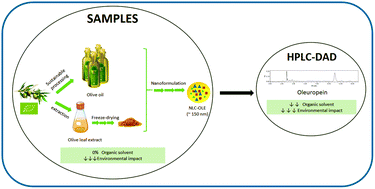Development and validation of an eco-friendly HPLC-DAD method for the determination of oleuropein and its applicability to several matrices: olive oil, olive leaf extracts and nanostructured lipid carriers
Abstract
Oleuropein is a natural ingredient largely used in nutritional supplements. This study reports on the development, validation and application of a HPLC method based on UV-vis detection for determining oleuropein in olive oil, olive leaf extracts and nanoparticles. The principles of green chemistry were taken into account for both sample manufacturing and HPLC method development. A Zorbax C18 column was used on which a mobile phase containing acetonitrile–water was applied in isocratic elution mode injecting 10 μl of sample at 1.2 ml min−1 constant flow-rate, 30 °C temperature and 15 minutes run time. Method linearity (r2 > 0.999) was assessed in the range of 50 to 420 μg ml−1. Precision expressed by RSD% was always better than 2%. Accuracy was in all cases within 98-102% of the expected concentration value. The sensitivity of the method was at a level of 0.08 μg ml−1 as the limit of detection and at 0.25 μg ml−1 as the limit of quantification. The results show that the method is suitable for the quantification of oleuropein in a variety of samples with reduced environmental impact.



 Please wait while we load your content...
Please wait while we load your content...